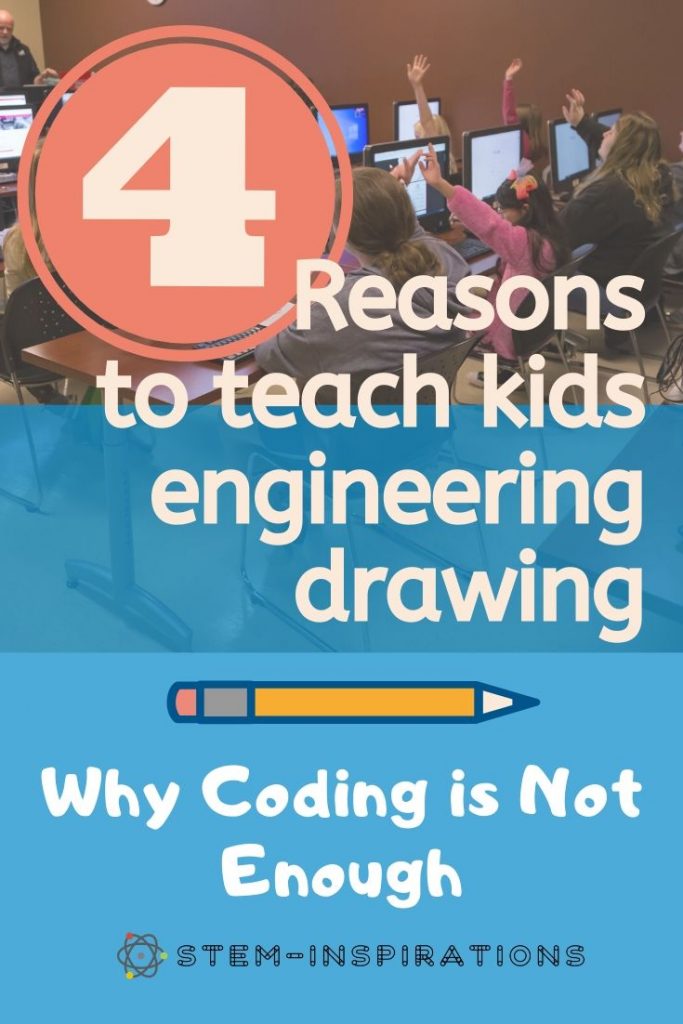
Coding and robotics curriculum, classes and clubs are springing up around the world. They promise to increase kids’ cognitive skills and creativity. But coding is not enough – they need spatial visualization skills that can be developed through learning engineering, or technical drawing.
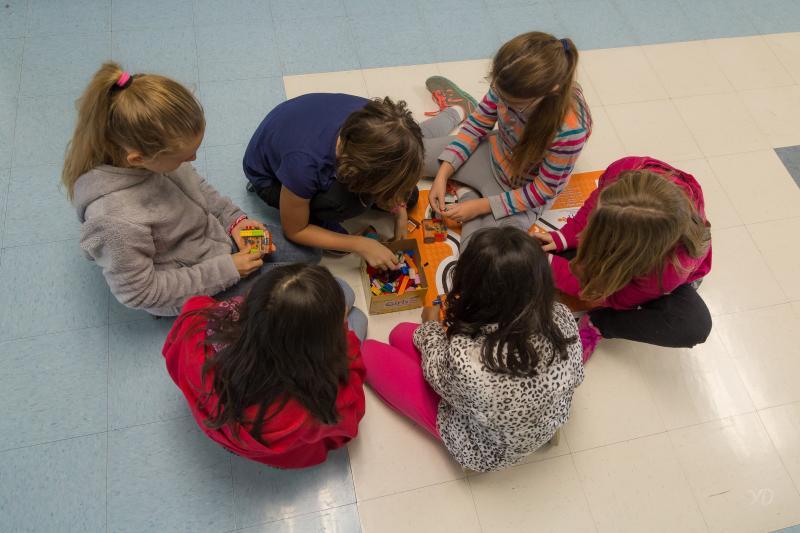
“Everybody in this country should learn how to program a computer…because it teaches you how to think.”
Steve Jobs
- Coding: Necessary but not sufficient?
- Logic vs. imagination
- A TEDx story
- Technical Drawing and the Engineering Design Process
- Real-world engineering drawing
- The language of engineering drawing
- 4 brain-boosting reasons to teach kids engineering drawing
- The importance of spatial visualization
- Developing spatial visualization with technical drawing
- Are makerspaces the solution?
- Coding supports the vision
Coding: Necessary but not sufficient?
But is learning to code enough? Are we giving our kids all the tools they will need to excel in their future careers?
The Steve Jobs quote above can be found on a video put out by code.org, called “What Most Schools Don’t Teach.” It’s a great video, but it leaves out another critical, and related skill that most elementary and middle schools don’t teach: technical drawing, also known as engineering drawing or drafting.
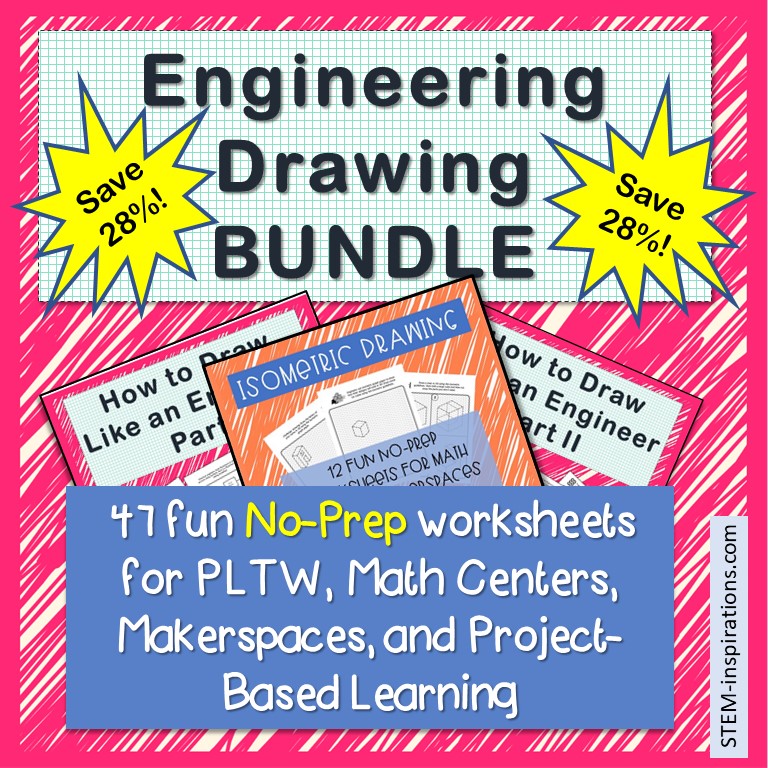
Teachers and homeschool parents can find these No-Prep technical drawing worksheets at the STEM-Inspirations Teachers Pay Teachers shop:
- How to Draw Like an Engineer – Isometric Drawing.
- How to Draw Like an Engineer – Part I
- How to Draw Like an Engineer – Part II
- No-Prep 3D Isometric Christmas Designs for Engineering, Math Centers, or PBL
- 3D Isometric Drawing and Design for Middle School
Please click to follow my TPT store for updates on products like these.
Here’s an example of why technical drawing is so important.
Recently, I volunteered at a coding and robotics club for girls in 5th through 8th grade. After working with miniature Edison robots for an hour to learn basic commands, the girls were asked to code the robots to drive in a square.
Logic vs. imagination
This was a logic problem: Break down the desired action into individual commands. But it was also a spatial visualization problem. Many (most?) of the girls were unable to conceptualize the specific actions the robot would need to take to accomplish the goal.
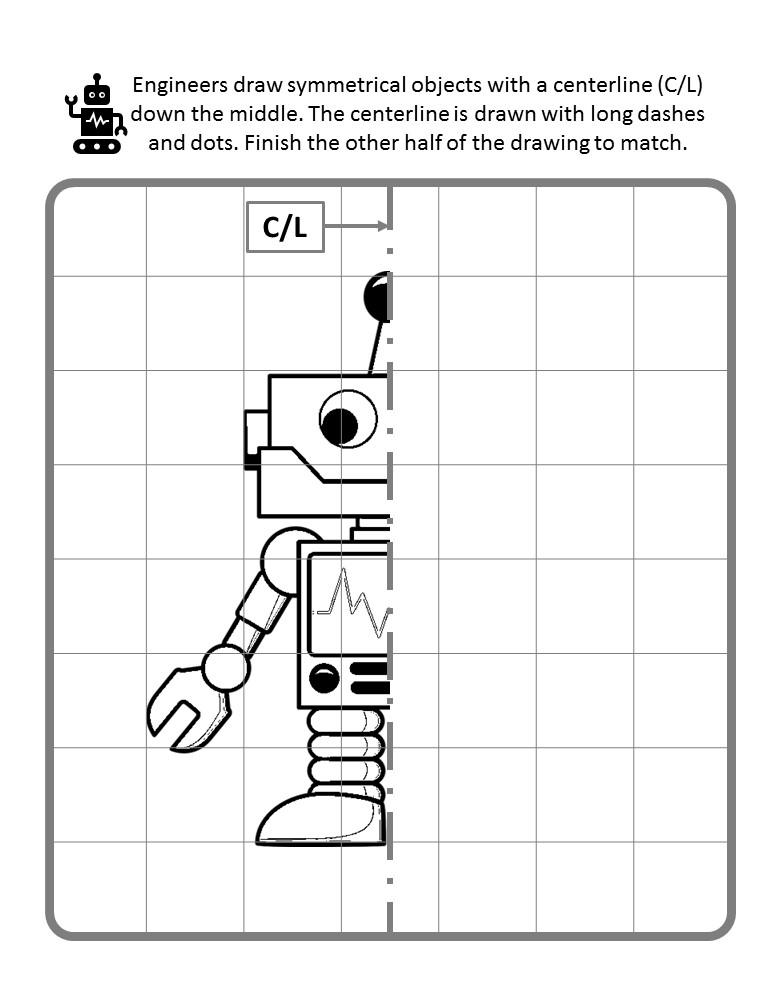
The other volunteers and I had to physically demonstrate. We picked up the robots in our hands and moved them across the floor or the desktop to show the actions that the robot needed to follow:
- move straight ahead for 3 seconds
- then pause
- then turn right 90 degrees
- move ahead another 3 seconds
- pause
- turn 90 degrees
- move ahead
- pause
- turn 90 degrees
- move ahead for 3 seconds to the original spot
- stop
Though we provided a real-life, 3D demonstration, we could have communicated the same concept by drawing the path of the robot in 2D on the whiteboard, using pictures, arrows, words, and numbers. In other words, a process flow diagram, which is one type of technical drawing.
A TEDx story
Technical drawing is the art and skill of expressing three-dimensional ideas using images, words and numbers that communicate those ideas to other people, to computers (coding) or to machines (robots), in order to manufacture an object or perform a process.
The importance of engineering drawing is illustrated in a popular TEDx talk by Debbie Sterling. Sterling is an engineer and the founder of GoldieBlox toys, designed to inspire future female engineers.
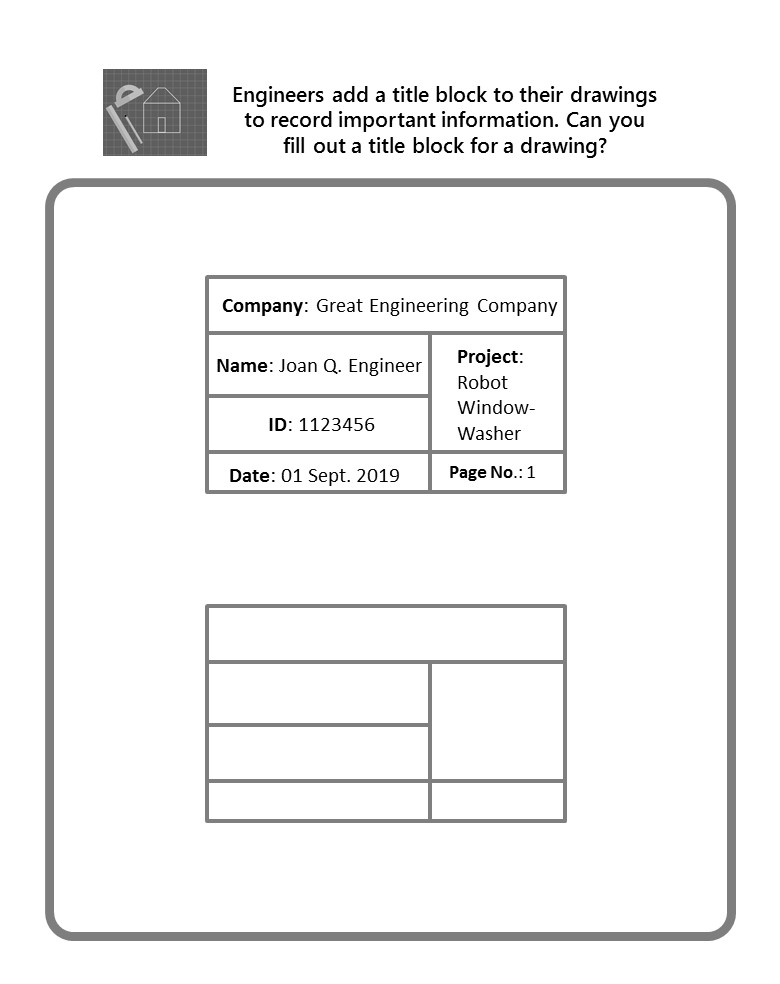
Sterling did well at Stanford’s engineering school until she enrolled in the required engineering drawing class. For one assignment, the students had to draw an object in 3D. After spending many frustrating hours, Sterling hung her project on the wall along with those of her mostly male classmates.
Humiliation
While examining the projects, her male professors humiliated her in front of the other students. They asked them, “How many of you think Debbie should pass this class?” And only a few students raised their hands.
Needless to say, she ran from the room in tears, thinking, “Maybe I should give up on engineering.”
But with the encouragement of a friend, she worked hard, re-did the drawing and graduated with a degree in engineering and product design.
Under-developed skills
Looking back, Sterling realized that her childhood had not provided the same preparation for a career in engineering as her male classmates. She discovered that, like many girls, her spatial skills were under-developed in comparison with boys. And she found that kids who grow up playing with construction toys, like Legos and wooden blocks, score higher on spatial skills tests.
This discovery led to her designing and manufacturing a construction toy that would help girls improve their spatial skills, in the same way that Lincoln Logs and Erector sets have taught boys for over a century.
Technical Drawing and the Engineering Design Process
Educators now believe that starting engineering education in high school is too late. By that time, many students, especially girls, have self-selected away from highly technical careers.
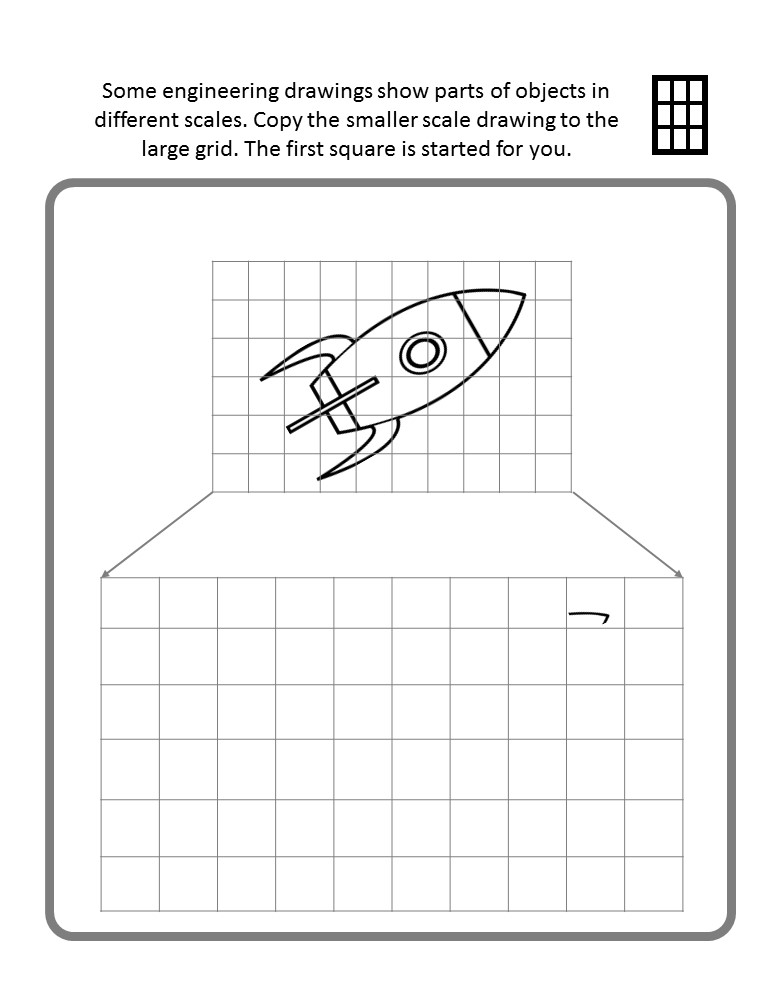
Recognizing this lack, the Next Generation Science Standards (NGSS) require elementary and middle school teachers to include the engineering design process in their classrooms. That process includes several steps that educators aim to teach even very young kids, including:
- Define a problem (design thinking).
- Collect information (research).
- Define requirements for a solution.
- Brainstorm possible solutions.
- Choose one solution.
- Design the solution (draw a labeled diagram, make a list of materials).
- Build a model of the solution (prototype).
- Test the model to see if it meets requirements.
- If not, repeat the above steps until the model satisfies requirements.
- Communicate the final solution to others (share).
The NGSS and technical drawing
Many steps in this process rely on some form of drawing, from labeled sketches to a presentation of the final solution. In fact, the NGSS engineering practices and disciplinary core ideas specify development of early skills in engineering drawing. For example:
K-2-ETS1-2. Develop a simple sketch, drawing, or physical model to illustrate how the shape of an object helps it function as needed to solve a given problem. (Grades K – 2)
Science and engineering practices: Develop a simple model based on evidence to represent a proposed object or tool.
Disciplinary core ideas: Designs can be conveyed through sketches, drawings, or physical models. These representations are useful in communicating ideas for a problem’s solutions to other people.
Real-world engineering drawing
In real-world engineering, technical drawings are the final deliverable for the engineering design process. Each drawing is actually a legal contract. Materials are specified. Parts are shown in different views to communicate every detail. Each dimension is labeled, and allowable tolerances to those dimensions are indicated. If the product is not manufactured according to each one of these specifications, it will be rejected.
By now you’re probably thinking, “Don’t engineers design everything on computers these days?”
It’s true that all manufacturing shops already use, or will ultimately use, computer-aided design and drafting (CAD) software to create their engineering drawings. CAD produces 3D images of a part or assembly that can be rotated in order to view it from all angles.
But in many respects, these 3D CAD images are just a beefed-up version of the 2D blueprints and technical drawings that have been used for hundreds of years. Any shop manager used to working with engineering drawings can look at a CAD design and instantly know how to build the product.
The language of engineering drawing
Engineering drawing, whether rendered by hand or software, is a specialized language of communication. Like fine art, it is a visual language with its own vocabulary and rules, or “conventions” that must be learned and followed. For example:
- The plan view of an object is the top view looking down from above.
- Orthographic projections are a set of three or more 2D drawings of an object that completely describe the object in 3D. The three drawings might be a front view, side view and top (plan) view.
- An isometric view is a conceptual 3D drawing of an object, with each dimension separated by 120 degrees (a simplified version of perspective drawing).
- An exploded view shows each part in an assembly spread apart in space, with direction lines showing how individual pieces fit into the completed product.
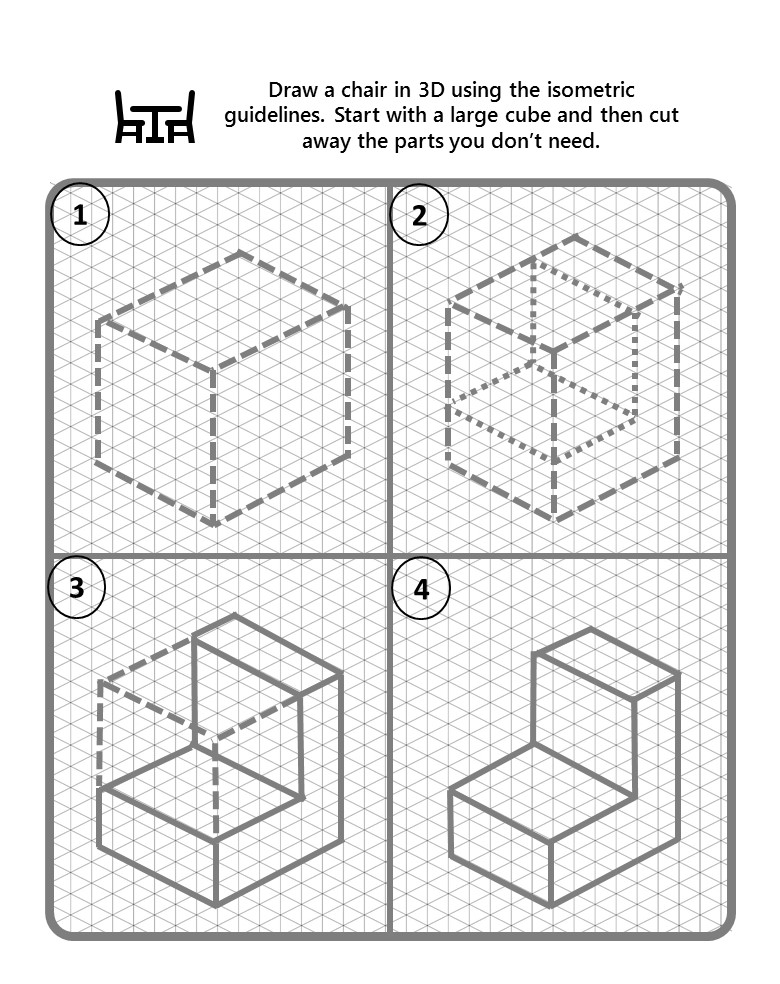
Does this seem too complicated for young children?
We all know that the younger the child, the more easily a second language can be learned, due to their speed of brain development. That’s why we encourage even toddlers and early elementary students to take Spanish class or “learn to code.”
At their age, we don’t expect them to learn Python or “C” language. We start with simple block coding, using pictures, such as arrows, drawn on each block to show commands.
Like coding, we also can begin to teach engineering drawing at an early age using correct vocabulary and simplified concepts.
4 brain-boosting reasons to teach kids engineering drawing
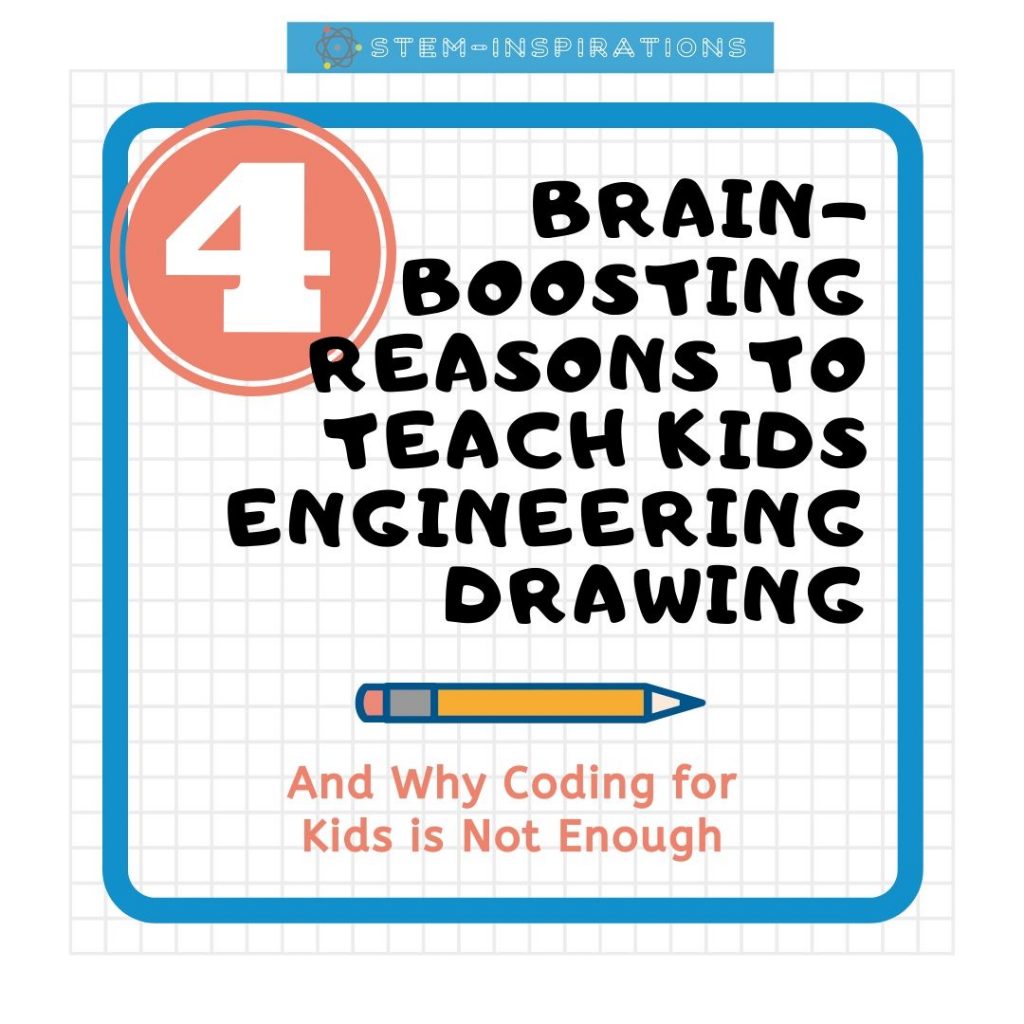
Learning to draw like an engineer provides any child—not just future engineers—with many benefits:
1. Drawing facilitates brain development.
In one study, five-year-olds who practiced drawing letters developed neural circuits in the brain that are known to facilitate reading.[1] Children who either typed or traced the same letters did not show the same brain activation.
2. Drawing helps students learn better.
Research in neuroscience shows that drawing is a powerful method of learning. Students who drew pictures of a list of words recalled more than twice as much as when writing notes, listening to a recording, or watching images on a screen.
3. Drawing encourages creative thinking.
Author Daniel Pink, in his book A Whole New Mind: Why Right-Brainers Will Rule the Future, believes that global forces are combining to reduce or eliminate logic-based, linear-thinking jobs, such as coding. Parents who want to equip their children for the 21st century, must help them develop creativity and innovative thinking—the so-called “right side of the brain.”
Pink claims that “design,” or the creation of something that doesn’t exist, is one of six right-brain skills. These skills can’t be outsourced to robots, computers, or call centers. And drawing is a powerful way to access and develop this skill.
4. Drawing improves spatial visualization skills.
To understand the concept of spatial visualization, try this mental test. Imagine a simple object that is not symmetrical, such as a coffee mug with a handle. Now, imagine turning the object on its side and rotating it a quarter turn. The process of producing that movie in your mind is spatial visualization.
The importance of spatial visualization
As Debbie Sterling learned, spatial visualization is crucial for most types of engineering. But it’s an important skill for many other careers as well. An interior designer must be able to envision the ideal placement of furniture in a room to allow it to “flow.” A biochemist must be able to conceptualize the physical interactions of complex three-dimensional molecules. A baseball player must understand the trajectory of a curve ball and adjust his swing to meet it with the bat.

Spatial visualization is involved in most types of drawing, except for something like a flat color pattern. Any type of figurative drawing involves translating 3D objects onto a 2D surface. We imagine something in our minds and then create an image on paper or on a computer screen to communicate our idea to other people.
The opposite process is also important: We can look at an image on paper and imagine or even build, the object in “real life.”
Developing spatial visualization with technical drawing
How do you teach spatial visualization to children? One way is to practice drawing simple 3D objects on isometric paper. Two types of pre-printed papers are available with either alternating rows of dots or with crossing grid lines that are equally spaced at 120° angles apart.
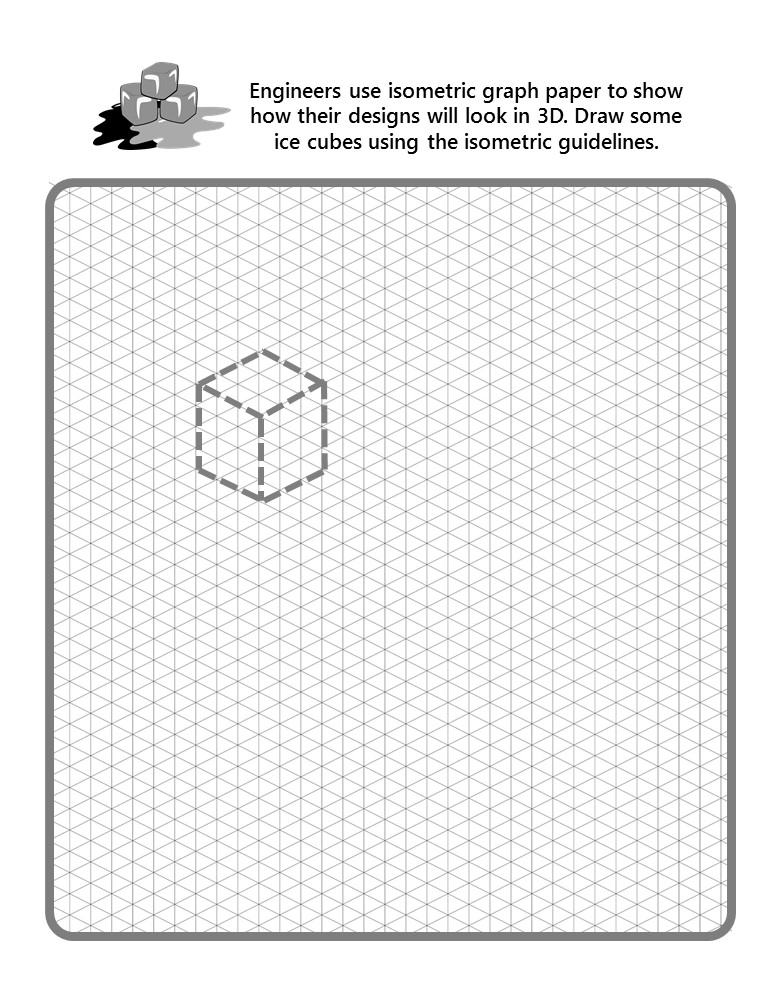
By connecting the dots or tracing the lines, kids can quickly and easily create realistic 3D drawings of simple cubes, stairways, furniture, buildings, etc. The resulting drawings can be amazingly life-like. And because they don’t require mathematical calculations, they open up a new world of creativity for kids of all ages.
Sadly, many general education elementary teachers, and even middle school science teachers, do not know how to teach engineering drawing. Concepts such as 3D geometric representation, scale and proportion are taught in middle school and high school math or art classes, rather than as an integral part of the engineering design process.
Online resources for teaching technical drawing for kids
The STEM-Inspirations TPT store offers downloadable worksheets that present the basic concepts and vocabulary of engineering drawing. Students also learn a simple way to create realistic, 3D drawings using isometric graph paper. They can then go on to sketch and draw their models and inventions for project-based learning.
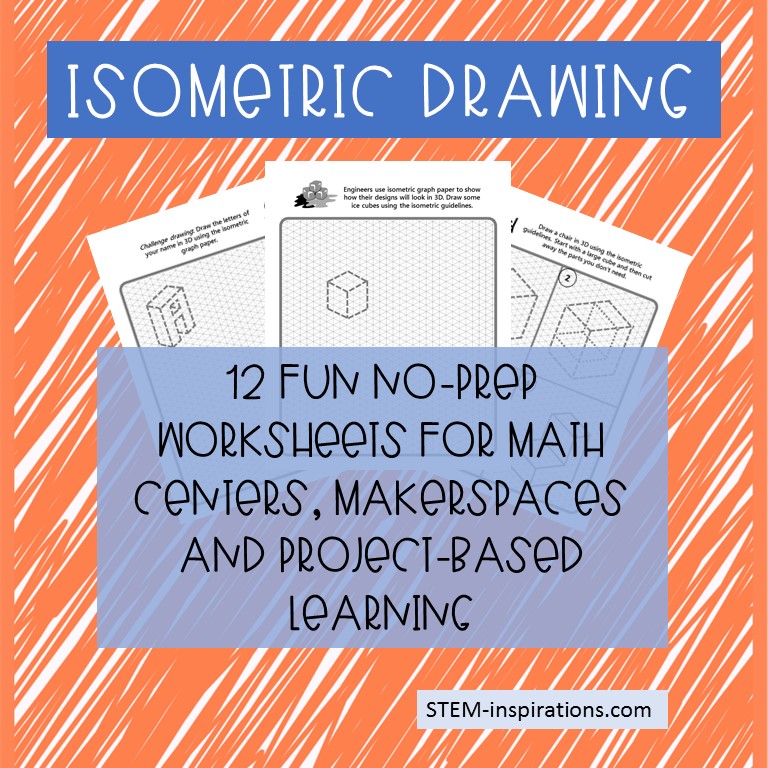
Teachers and homeschool parents can find the following no-prep resources to help teach technical drawing for kids at the STEM-Inspirations Teachers Pay Teachers shop:
- How to Draw Like an Engineer – Isometric Drawing.
- How to Draw Like an Engineer – Part I
- How to Draw Like an Engineer – Part II
- No-Prep 3D Isometric Christmas Designs for Engineering, Math Centers, or PBL
- 3D Isometric Drawing and Design for Middle School
Please click to follow my TPT store for updates on products like these.
A few free online resources that teach technical drawing can be found with lesson plans, worksheets and rubrics. For example, Teachengineering.org offers a wonderful PreK-12 engineering curriculum, including a set of lessons on spatial visualization and isometric drawing.
The National Council of Teachers of Mathematics offers a free interactive online isometric drawing tool. You can create simple 3D creations on an isometric dot grid and then rotate them to view from all angles. You can also convert them to 2D orthographic representations showing the front, side and top views. Recommended for students from Grades 3 through 12.
Another great resource for improving spatial visualization is the free simple CAD program at Tinkercad.com. Students use the program to design a wide range of ideas in 3D, such as key rings, plant pots, and even dinosaurs. The software allows them to build an isometric image of a design and rotate it to view it from all angles. Afterwards they can construct the design using Legos or download it as an STL code file to print out on a 3D printer.
Are makerspaces the solution?
Many schools are creating makerspaces to integrate the NGSS standards into their curriculum. Often, these are simply a corner of the classroom or library filled with an assortment of Legos and craft supplies. The lucky ones may include a laptop and a 3D printer.
If students are working on project-based learning in the makerspace, they may be asked to sketch their ideas on a worksheet. But typically, they don’t have much guidance when it comes to accurately drawing their models.
This paperback activity book gently introduces students to engineering and technical drawing concepts and vocabulary—no math required! One 4th grade teacher at a STEM school found this book a great addition to the makerspace in his classroom:
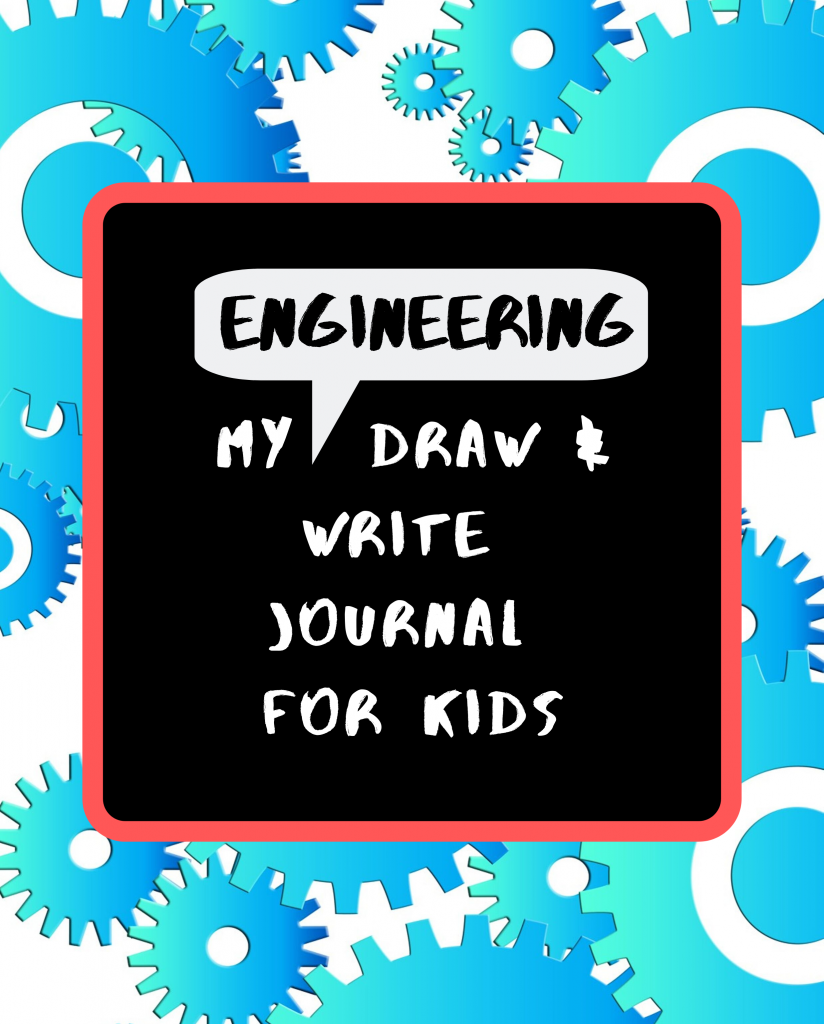
One 4th grade teacher at a STEM school found this book a great addition to the makerspace in his classroom:
“I am so glad I got this book…With the Next Generation Science Standards having engineering design as an integral component of science instruction, this book will prove very valuable! It walks kids through how to design their ideas in a way that is accurate and useful, and it teaches them how to think through that process. Modeling is such an important aspect of the engineering design process, and this book will help immensely. It trains kids to do scale models, 3D models, front/side/plan models, cutaway models, and much more, and I can’t wait to start using it with my students.”
Amazon Customer Review
Coding supports the vision
Coding is helpful for the backend of the engineering design process. But to reach the backend, first we must focus on the front-end: Design and creative imagination. We envision what we want to create, and then “bring it to life” in the real world. Both processes require spatial visualization skills.
Engineering drawing is one way to strengthen a child’s ability to imagine and manipulate objects in their minds. It can be a powerful and highly useful way to teach NGSS and other academic standards—even at the elementary level!
In other words, coding supports the vision, but coding is not the vision itself.
Note: This article first appeared on LinkedIn.
You May Also Enjoy Reading
Teach STEM at home the easy way with NO-PREP printable worksheets and activity books
17 Simple [Research-Based] Ways to Help your Child Learn Better that Don’t Involve Schoolwork
Review: All Morphed Up! A Fun and Easy STEAM Activity
Holly B. Martin is a science writer and the author of My Engineering Draw & Write Journal for Kids: 48 Fun Drawing and Writing Prompts to Learn about the Engineering Design Process. She has also written other STEM activity books, including My Science Draw & Write Journal for Kids: 52 Unique Drawing and Writing Prompts to Help Young Scientists & Engineers Explore the World.
Visit the Holly B. Martin STEM-Inspirations Teachers Pay Teachers store for a wide selection of STEM education resources.
[Click here to join the STEM-Inspirations mailing list and download a set of science-themed journaling pages.]
Copyright © 2019-2022 by Holly B. Martin and stem-inspirations.com. Use and/or duplication of articles, images, and website content is strictly prohibited. A direct link may be used, provided that full credit is given to Holly B. Martin and STEM-Inspirations.com. All rights reserved.
[1] Karin H. James and Laura Engelhardt. “The effects of handwriting experience on functional brain development in pre-literate children.” Trends in Neuroscience and Education.
https://doi.org/10.1016/j.tine.2012.08.001, accessed on 11/18/19 in https://www.sciencedirect.com/science/article/pii/S2211949312000038
